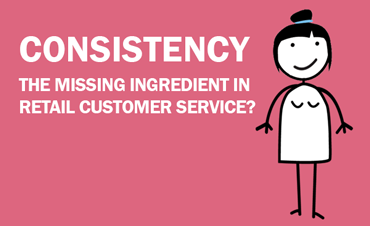Consistency – the missing ingredient in retail customer service?

When it comes to customer service, consumers want the ability to contact you through their channel of choice and get the same positive experience - receiving fast, accurate and consistent answers - however they get in touch.
Delivering consistency is therefore important to both customers and the organization itself. Inconsistency frustrates consumers as they cannot be sure that they’ve received the ‘right’ answer to their query. Consumers are likely to re-contact the company to check their answers, pushing up interaction volume, and so adding to a company’s costs. In addition, running each channel separately, with its own knowledge base is inefficient and expensive. Furthermore, giving an inconsistent answer might have a financial or regulatory impact on the business – for example, if agents answering on Twitter are not following company policy and are offering free shipping it could hurt the bottom line. Even worse, if they work for a financial services company and are not providing approved answers, the business could be in breach of regulations, leading to potential fines and damage to brand reputation.
Retailers are multichannel, but not consistent
So, how good are U.S. retailers in particular at being consistent and multichannel? As part of the2015 Eptica Multichannel Customer Experience Study, which evaluated 500 midsize retailers, companies were scored on both the number of channels they offered – and their consistency when answering the same question across the web, email, Twitter, chat and Facebook.
On the positive side, U.S. retailers understand the importance of being multichannel, with 84% of those surveyed offering customer service via email, Twitter, Facebook and chat, alongside their website.
However, issues arose when it came to actual delivery. Just over half (51%) provided answers across the four digital channels of Twitter, chat, Facebook and email. Essentially a large number of retailers are not delivering on their multichannel promises, meaning they are letting down customers, who expect a response that never arrives.
These results point to retailers taking a channel-by-channel approach to answering queries. Just 2% of companies were able to hit the gold standard of providing a consistent response across every one of the web, chat, email, Facebook and Twitter channels, with a further 12% delivering on four channels. 4% of Apparel retailers answered on every channel, compared to scores of zero for eight other sectors.
Consistently inconsistent
Overall, one third (33%) of retailers completely failed the consistency test, either because their answers didn’t match, or because they were unable to provide answers on more than a single channel. There was significant variation between sectors – 50% of Automotive Accessories retailers had no consistent answers, compared to 15% of Flowers/Gifts vendors.
Again, this is likely to be caused by each channel being managed in isolation, by separate teams without sharing information across the organization. In today’s world, where consumers want to be able to move seamlessly between channels, this silo-based approach simply doesn’t deliver the flexibility or service required.
Increasing consistency
How can retailers improve their consistency, and consequently increase both customer satisfaction and efficiency? Here are four areas to focus on:
1. Centralize knowledge
Knowledge powers customer service, and if every channel relies on separate stores of information, consistency is likely to be poor and costs may rise, as the business has to maintain and update multiple knowledge sources. By centralizing information in a single knowledge base, and making it available to agents working on every channel, as well as through web self-service, companies can ensure consistency and increase efficiency at the same time.
2. Break down silos
In the Eptica research many retailers that scored highly on one channel completely failed to answer the same question when asked it on a different channel. This points to a silo-based approach to customer service, with each team focused solely on ‘their’ channel, and resources not being shared across the organization. Retailers, particularly midsize ones, should take a holistic view and train agents so that they can work across channels when necessary to help reduce waiting times.
3. Integrate systems
Today’s consumers will use multiple channels within the same interaction – they may begin on the web, switch to email and then move to social media, depending on their requirements and preferences. Companies need to be able to respond to this multichannel approach by integrating their systems so that agents can see the complete customer journey when answering a query, enabling them to tailor their answers so that they are not simply repeating information that has already been provided.
4. Investigate creating Customer Hubs
The customer journey crosses multiple departments and involves interaction with employees with different skills (such as sales, marketing, customer service, and finance). Traditionally, these all sat in individual departments, with little interconnection or communication. This doesn’t meet the needs of 21st century consumers, so forward looking companies are therefore adopting Customer Hubs. These bring together staff with different skills into a single team and location, enabling them to provide the integrated, holistic experience that customers require. Customer Hubs canstart small, with just a few members, but can then be grown and extended as they prove their worth.
You can download the full 2015 Eptica Multichannel Customer Experience Study here or see key findings in this infographic. If you would like to discuss any of the findings or schedule a demo of Eptica's multichannel customer interaction management software, please don't hesitate to contact us.







Comments